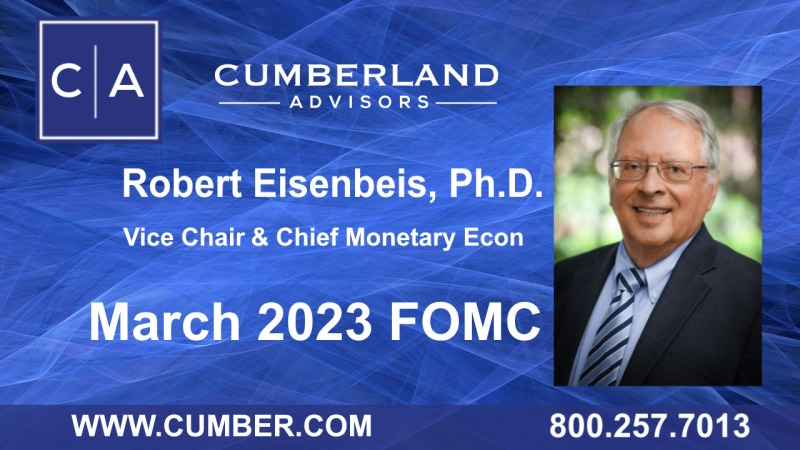The FOMC raised its federal funds target rate for the ninth time, to 4.75–5.0%, continuing its pattern of tightening policy rates in 25-basis-point increments. It also maintained its current policy of gradually reducing its holdings of Treasury and agency securities. It continued this policy path despite the turmoil in financial markets this past week, with the failures of Silicon Valley Bank and Signature Bank; the rough time that First Republic Bank experienced; the acquisition of Credit Suisse by UBS; and the Fed, Treasury, and FDIC’s putting in place emergency facilities that effectively guaranteed all bank deposits. As a prelude to discussing the FOMC decision, Chairman Powell began his press conference with a statement that the banking system was sound and that people should not worry.

But the real story this time around was in the new Summary of Economic Projections (SEPs), the first for 2023, which updated the FOMC’s December SEPs. There were remarkably small changes in the key numbers, given the strength of the economy and all that has happened since December. For example, GDP growth for 2023 was reduced from 0.5% to 0.4%; in 2024, it was reduced from 1.6% to 1.2%; and in 2025, it was actually increased from 1.8% to 1.9%. At the same time, the unemployment rate was largely unchanged, as was the path for inflation, which declined from 3.3% in 2023 to 2.1% in 2025, essentially achieving the Fed’s 2% target. These remarkably small tweaks were made despite what was admittedly a much stronger labor market than had been expected and despite only modest moves in PCE inflation over the intervening period between SEPs.
While most of the focus at the post-FOMC press conference was on the SVB failure and related banking problems, one reporter asked whether recent events had impacted the expected final stopping point for the terminal fed funds target. The answer was obvious if the reporter had digested the SEPs. The year-end fed funds rate remained at 5.1% by the end of 2023, suggesting one more 25-basis-point rate hike, followed by two or three rate cuts in 2024 and two or three cuts in 2025, ending at 3.1%. This observation was confirmed by looking at the dot plots for 2023. Ten participants saw the rate at 5.0–5.25%; seven saw the rate a bit higher; and one favored a rate range of 4.75–5.0%. (Note that there were only 11 members voting because of the vacancy created by the departure of Lael Brainard.)
Perhaps the most telling of the responses to questions concerning the crisis was that participants had vectored it into their projections. Moreover, to the extent that the crisis might lead institutions, especially smaller ones, to tighten credit stands, this result would serve to complement the FOMCs rate increases and reduce the need for additional tightening. One reporter asked if fiscal policy had contributed to inflation but might now be used to cut upward demand pressure on prices. Powell provide a two-part response. Early in the pandemic, fiscal policy did contribute to price pressures; but he did not see that dynamic operative now. But he also noted that fiscal policy was not in the FOMC’s purview, and the committee simply took it as a given that had to be considered.
Finally, with respect to what went wrong this time that contributed to the turmoil, Powell indicated that, while supervisors had recognized the problem of lack of diversification and extreme interest-rate risk-taking, the Board was conducting an internal review and would change supervisory and regulatory policies as needed. Interestingly, when asked if the system would be subject to an outside review, Powell indicated that such a review would be welcomed. This response is unusual since the system is unusually protective of its independence, especially should a review involve Congress.
Robert Eisenbeis, Ph.D.
Vice Chairman & Chief Monetary Economist
Email | Bio
Links to other websites or electronic media controlled or offered by Third-Parties (non-affiliates of Cumberland Advisors) are provided only as a reference and courtesy to our users. Cumberland Advisors has no control over such websites, does not recommend or endorse any opinions, ideas, products, information, or content of such sites, and makes no warranties as to the accuracy, completeness, reliability or suitability of their content. Cumberland Advisors hereby disclaims liability for any information, materials, products or services posted or offered at any of the Third-Party websites. The Third-Party may have a privacy and/or security policy different from that of Cumberland Advisors. Therefore, please refer to the specific privacy and security policies of the Third-Party when accessing their websites.
Cumberland Advisors Market Commentaries offer insights and analysis on upcoming, important economic issues that potentially impact global financial markets. Our team shares their thinking on global economic developments, market news and other factors that often influence investment opportunities and strategies.

